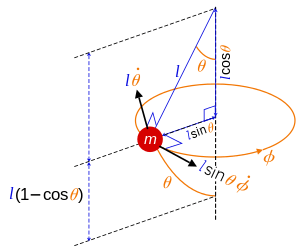Spherical pendulum
In physics, a spherical pendulum is a higher dimensional analogue of the pendulum. It consists of a mass m moving without friction on the surface of a sphere. The only forces acting on the mass are the reaction from the sphere and gravity.

Spherical pendulum: angles and velocities.
Owing to the spherical geometry of the problem, spherical coordinates are used to describe the position of the mass in terms of (r, θ, φ), where r is fixed. In what follows l is the constant length of the pendulum, so r = l.
Lagrangian mechanics
The Lagrangian is [1]
The Euler–Lagrange equations give :
and
showing that angular momentum is conserved.
The conical pendulum refers to the special solutions where and is a constant not depending on time.
Hamiltonian mechanics
The Hamiltonian is
where
and
gollark: No, you don't have breaks because breaks mean less macron.
gollark: <@!341618941317349376> make macron.
gollark: WRONG.
gollark: So it is probably not [REDACTED] my browser at least.
gollark: * server
See also
References
- Landau, Lev Davidovich; Evgenii Mikhailovich Lifshitz (1976). Course of Theoretical Physics: Volume 1 Mechanics. Butterworth-Heinenann. pp. 33–34. ISBN 0750628960.
- Weinstein, Alexander (1942). "The spherical pendulum and complex integration". The American Mathematical Monthly. 49 (8): 521–523. doi:10.1080/00029890.1942.11991275.
- Kohn, Walter (1946). "Countour integration in the theory of the spherical pendulum and the heavy symmetrical top". Transactions of the American Mathematical Society. 59 (1): 107–131. doi:10.2307/1990314. JSTOR 1990314.
- Olsson, M. G. (1981). "Spherical pendulum revisited". American Journal of Physics. 49 (6): 531–534. Bibcode:1981AmJPh..49..531O. doi:10.1119/1.12666.
- Horozov, Emil (1993). "On the isoenergetical non-degeneracy of the spherical pendulum". Physics Letters A. 173 (3): 279–283. Bibcode:1993PhLA..173..279H. doi:10.1016/0375-9601(93)90279-9.
- Shiriaev, A. S.; Ludvigsen, H.; Egeland, O. (2004). "Swinging up the spherical pendulum via stabilizatio of its first integrals". Automatica. 40: 73–85. doi:10.1016/j.automatica.2003.07.009.
- Essen, Hanno; Apazidis, Nicholas (2009). "Turning points of the spherical pendulum and the golden ration". European Journal of Physics. 30 (2): 427–432. Bibcode:2009EJPh...30..427E. doi:10.1088/0143-0807/30/2/021.
- Dullin, Holger R. (2013). "Semi-global symplectic invariants of the spherical pendulum". Journal of Differential Equations. 254 (7): 2942–2963. doi:10.1016/j.jde.2013.01.018.
This article is issued from Wikipedia. The text is licensed under Creative Commons - Attribution - Sharealike. Additional terms may apply for the media files.